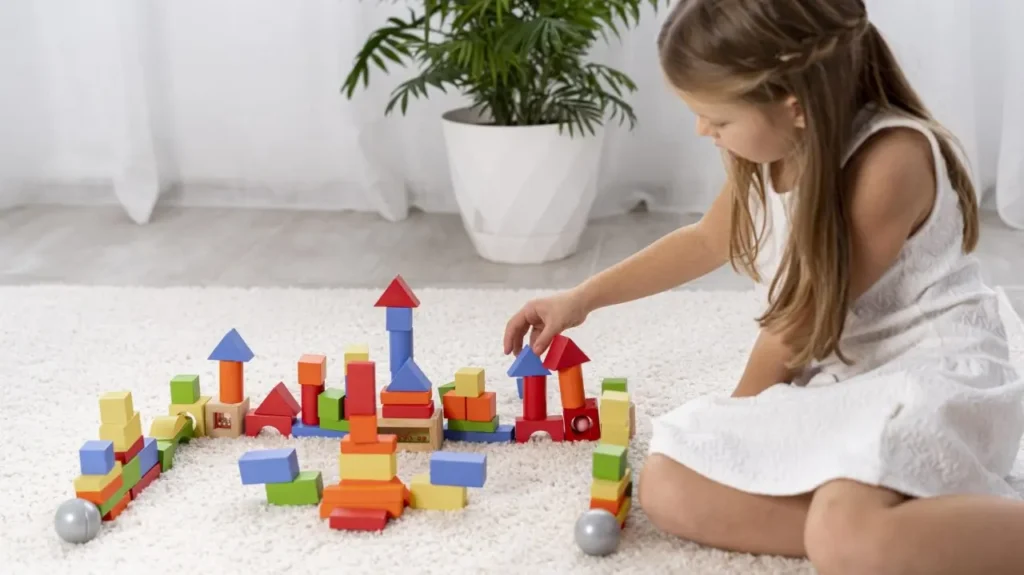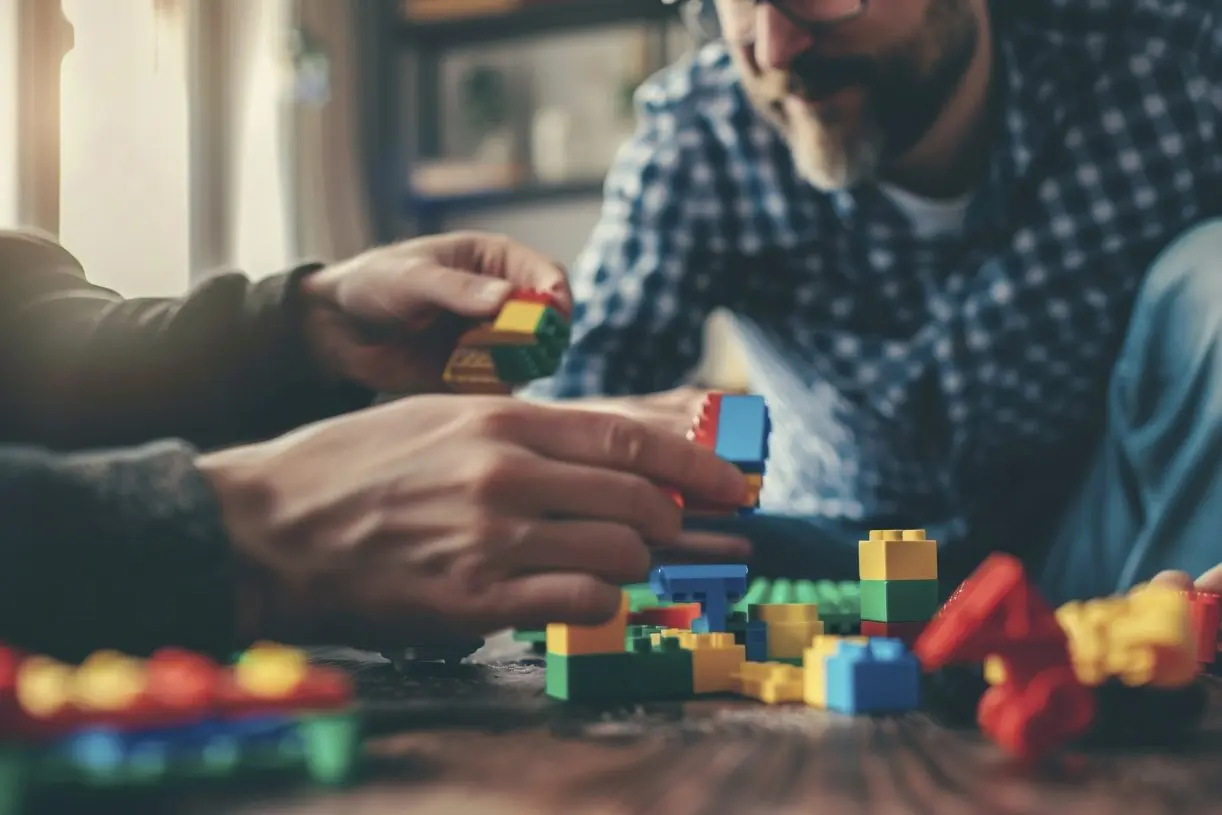Blocks are undoubtedly one of the most popular and universal toys you can give to a child. They have accompanied young ones for generations, captivating with their simplicity and at the same time providing almost limitless possibilities for play and learning. Today, we have at our disposal not only classic wooden blocks, but also a huge variety of options such as construction blocks for children, remote-controlled blocks for kids, or technical blocks. Each year, the range of specialized sets grows, making it possible to build not just simple houses or towers, but also moving vehicles, detailed structures, and even architectural blocks for adults. In this article, we will look at why it is worth incorporating blocks into a child’s daily play, how they contribute to a child’s development, and which types of blocks are available on the market. We will also discuss at what age a child can use specific types of blocks, as well as the benefits adults can derive from building, for instance with CADA Bricks or Mould King blocks.
Why is it worth having a child play with blocks?
Children usually encounter their first blocks for building as infants. Early on, a baby simply explores various shapes—becoming familiar with colors, smells, and the weight of individual pieces. A bit later, they discover that blocks can be stacked on top of each other, and soon after, they begin to form intentional yet simple structures. Playing with blocks delivers numerous stimuli and positively impacts a child’s intellectual, motor, and social development.
- Fine motor skills development: Handling blocks helps a child practice precise finger and hand movements. This is extremely important, as the same skills will be useful later when learning to write or draw.
- Spatial thinking development: Even simple tower-building teaches a child how elements fit together in three-dimensional space. With construction blocks for children, they must think logically and predict how each subsequent block will affect the entire structure.
- Stimulating imagination and creativity: A child can create houses, vehicles, or imaginative worlds. Blocks spark an urge to experiment, which fosters inventiveness.
- Building social skills: Group play or playing with siblings encourages sharing, joint planning, and communication. Working together can be faster or more fun—children might build a large project or assign roles within a made-up scenario.
- Learning concentration and patience: Constructing a stable structure out of blocks requires focus and a well-thought-out plan. Even if the tower collapses, the child trains perseverance by trying again.
What kinds of blocks are there for children?
Thanks to technological advancements and the ingenuity of manufacturers, there is now a wealth of block variants on the market so that everyone can find something suitable for their child’s age, interests, and abilities. Below are the most popular types.

- Classic wooden blocks
These are the simplest and most traditional type of block. Made of natural material, they are durable and safe for a little one. They usually have basic geometric shapes (cubes, rectangular prisms, cylinders), which makes them great for creating first structures. For toddlers, they serve as an excellent introduction to practicing grip and learning about colors and shapes. - Construction blocks for children
This category includes a huge variety of products, from simple sets with “click” connections to more complex systems resembling 3D puzzles. Construction blocks develop logical thinking because pieces must be connected in a specific way. Children can build functional objects—bridges, building models, or even mechanisms with moving parts. - Technical blocks
These are an advanced type of construction block, often featuring gears, axles, transmissions, or small motors. They allow children to create vehicles, robots, and other machines with moving parts, introducing them to basic engineering and mechanics. Many popular block lines have “technic” series aimed at older kids and adolescents. In this context, we can also mention technical blocks for children, which provide great satisfaction upon completing the project. - Remote-controlled blocks for kids
Taking things up a notch, these blocks include motors and electronic modules so the resulting models can be operated via remote control. They might be blocks vehicles for children—cars, boats, construction machinesdfgfdfdfdfdfdfdf, and many other items that truly drive, steer, or lift a bucket. For many children, it’s an excellent way to combine a passion for building with a fascination for remote control technology. - Construction straws for children
This kind of block uses flexible tubes (straws) and connectors, allowing the building of light yet large spatial constructions. Children can build tents, domes, or bridges. Thanks to the straws’ flexibility, it’s easy to create unusual shapes, enriching play and developing spatial reasoning. - Magnetic blocks (klocki magnetyczneegferfzieci)
Here, pieces connect through magnets. They may come as flat tiles with magnetic edges or as solid 3D shapes. The magnetic attraction does away with traditional studs or sockets. Creating stable constructions takes some skill, which fosters coordination and logical thinking. - Themed blocks for children
More and more companies offer sets focused on certain motifs—such as blocks cars for kids, blocks flowers for children, or blocks buildings for kids. Hence a child who loves cars can create various vehicles, while a nature enthusiast can assemble floral designs. - Construction sets like CADA Bricks, Mould King
These are more advanced series, often resembling “adult” model kits. CADA Bricks and Mould King emphasize modern design, precision, and numerous expansion possibilities, appealing not only to children but also to parents. - Blocks for girls and blocks for boys
Theoretically, any child can enjoy all blocks regardless of gender, yet producers often release lines aimed at a specific group. Sets “for girls” might feature pastel colors and floral motifs (e.g., blocks flowers for children), while “for boys” might highlight sports, construction, or military themes. Of course, that doesn’t mean girls cannot play with blocks cars for kids, nor that boys must skip flowery sets. Ultimately, the choice should align with individual interests. - Maxi blocks for children and XXL blocks for kids
These are large blocks, perfect for the youngest kids who are just discovering the basics. A bigger block is easier to grip and less likely to be swallowed, increasing safety. Consequently, even a one-year-old can start learning how to build, and parents needn’t worry about choking hazards.
At what age can children play with blocks?
The age at which children begin playing with blocks can vary greatly. One child might start constructing rudimentary structures at 12 months old, while another might do so at 2 years old. The key is matching the block type to a child’s developmental stage and manual dexterity.
- 1–2 years old: At this stage, big blocks for children and XXL blocks for kids are recommended. Infants mainly grasp blocks and place them side by side or knock down structures built by a parent. Pieces should be soft or wooden, free of sharp edges, and large enough that the child can’t swallow them.
- 2–3 years old: The child gains more skill. They begin to link blocks into small constructions and understand how to build towers or walls. Large elements remain best, though not necessarily as large as in the previous age range. Simple construction blocks can be gradually introduced.
- 3–5 years old: At this age, children usually enjoy more complex sets. They might build small houses or vehicles and can discover construction straws for children or magnetic blocks (klocki magnetyczneegferfzieci). Simple building blocks that include moving parts work well. It’s also a good time for them to explore blocks cars for kids or blocks flowers for kids, encouraging them to act out different scenarios.
- 5–7 years old: Children become more independent and realize they can replicate actual structures using blocks. Sets labeled “construction” or “technical” blocks are suitable now, where the child follows instructions and searches for the right pieces. They might also enjoy blocks vehicles for kids, like cars or excavators. Some sets can be quite large and require concentration and patience.
- 7–10 years old: Children may become interested in remote-controlled blocks for kids or sets akin to technical blocks for children, enabling them to build complex projects with gears, lifts, etc. They might also move on to CADA Bricks or Mould King if their curiosity and skill level is high. Following multi-step instructions hones analysis and focus.
- 10–14 years old: Young builders at this stage often embrace advanced sets, sometimes modifying existing designs or building entirely from imagination. Blocks vehicles for kids with remote control can spark a love of robotics. Also, more elaborate architectural blocks for adults can intrigue some older kids who enjoy the challenge of accurately recreating famous buildings.
- 14+ and adults: While many people think blocks are only for children, there’s a market for adult-focused products—like architectural blocks for adults—allowing you to construct models of famous buildings with remarkable detail. Many treat these sets as a hobby or a way to relax while polishing manual skills. Motorsports enthusiasts can try advanced technical blocks replicating engines or chassis. Others opt for Mould King or CADA Bricks sets to build large-scale ships, castles, or futuristic machines. Playing with blocks as an adult is not just a nostalgic trip back to childhood; it’s also a means to cultivate creativity and unwind by assembling tiny pieces.
Blocks for adults – does it make sense?
In the past, it was believed one could “outgrow” playing with blocks. But with the rise of collector and architecture-themed sets, more adults are discovering the fun of building. It’s a fantastic way to de-stress and develop spatial skills. In stores, you can find architectural blocks for adults, enabling you to recreate iconic world buildings—towers, bridges, even entire neighborhoods on a small scale. The finished models can serve as decorative pieces at home or in an office, reminding you of the joy of building.
Moreover, building blocks together with a child reinforces family bonds. Adults get to display their skills while teaching the youngster about logical thinking and problem-solving. Technical blocks can captivate the whole family for hours, and the final outcome—like a realistic model car or a helicopter—offers a sense of pride and joy in having accomplished a shared project. Often, the parent is more enthusiastic about constructing, while the child watches and contributes ideas. It’s essential to match the difficulty level to everyone’s abilities.
Blocks and mental and emotional development
One of the most common questions parents ask themselves is whether blocks truly aid a child’s development. The answer is a resounding yes, in many different ways. Playing with blocks—whether classic wooden blocks or advanced technical blocks for children—encourages children to decide how to combine elements to get the desired outcome. They also practice patience, as sometimes structures don’t come out right on the first try.
On an emotional level, creating something from scratch boosts self-esteem. When a child sees the final house or vehicle they’ve built, they feel pride in their own effort (or shared effort with siblings or parents). If the structure includes moving parts or can be remotely controlled (remote-controlled blocks for kids), the sense of success is even greater. Remember that it’s the adults’ role to support but not do the work for the child. Let them solve construction problems independently, stepping in only if asked.
Variety of themes and motifs
One major advantage of blocks is their thematic variety. The market offers sets representing many worlds, from medieval castles and pirate ships to futuristic scenarios or designs linked to popular movies. In addition, there are blocks for boys and blocks for girls, though these categories increasingly overlap—most children simply enjoy building. It’s more important that the theme reflects the child’s interests and passions. If the child adores cars, blocks cars for children will be perfect. If they love nature, blocks flowers for children might be the way to go. If they dream of being on a construction site, construction machinesdfgfdfdfdfdfdfdf sets will be a hit. That bridging of imagination and reality fosters learning through play.
How to support a child’s block play?
To make the most of block play, bear a few tips in mind:
- Age-appropriate: If the set is too difficult, it can discourage a child; if it’s too easy, they might get bored quickly. That’s why matching blocks to the child’s ability is vital.
- Shared start: If the child isn’t sure where to begin, help them place the first few pieces or demonstrate connections. Then step back to let them explore independently.
- Encourage experimentation: Prompt them to try new solutions and explain why some structures might collapse. This is important for learning not to fear mistakes.
- Positive communication: Avoid criticism like “You’re building it wrong.” Instead, say, “Maybe you could add another block on the other side to make the tower more stable?”
- Organize the space: It helps to have a designated area for the child to spread out blocks where everything is easily accessible. Dividing pieces into containers by type teaches tidiness and makes it easier to find the right parts.
Blocks in preschool and school education
Many educational institutions see the value in using blocks. Preschools and schools often incorporate them into construction activities that help children learn basic math (counting, grouping shapes), geometry (recognizing shapes and solids), and even physics (gravity, balance). Sets labeled as “construction” introduce collaboration: children work on a shared project, developing teamwork skills and taking on different roles in the group. These exercises with blocks bolster STEM competencies (science, technology, engineering, math) from an early age. They also inspire curious questions like “Why won’t it stick?” or “How can we strengthen the foundation?”, fostering creative thinking and problem-solving.
The role of blocks in therapy and developmental support
Blocks also play a key role in therapy for children with special educational needs. Specialists (speech therapists, special education teachers, sensory integration therapists) frequently use blocks to develop concentration, visual perception, or fine motor skills. They can help kids learn to match shapes, identify colors, or replicate sequences. Children with coordination difficulties get a chance to refine their grasp and eye–hand coordination through an enjoyable form of play. Collaborative building with peers can boost a sense of belonging and acceptance.
Trends and the future of blocks
Looking at the toy market’s trajectory, it’s clear that blocks won’t go out of style. On the contrary, they continue to evolve and provide new forms of play. Interactive solutions that blend physical blocks with mobile apps or virtual reality are emerging. At the same time, many people cherish the classic approach—valuing direct contact with a physical material. Eco-friendly sets made from recycled or natural materials are also popular, matching growing environmental awareness.
Many manufacturers lean toward themed blocks that encourage specific activities: blocks buildings for kids enabling the construction of castles, towers, or fortresses, or XXL blocks for kids suitable for big group play—whether in preschool rooms or children’s clubs. For those wanting to push boundaries, some sets include motors, cables, and LED diodes for flickering or lighted structures or self-built robots.
Blocks in the context of technological development
It’s impossible not to mention recent projects integrating blocks with programming. These solutions let a child build and code their own robot, which reacts to light or motion sensors. They’re more advanced but introduce STEM topics in a fun, hands-on way. Similarly, remote-controlled blocks for kids show that creativity can take the form of a custom-built model that actually responds to commands—car, machine, or drone. Children see that a block-based creation can be more than a static display; it can become an interactive object responding to instructions.
A final look at the benefits of block play
Though this article doesn’t require a formal conclusion, it’s worth emphasizing the key advantages of blocks. They comprehensively nurture a child’s development, from refining fine motor skills to understanding spatial relationships and social interaction. They also serve as incredibly flexible toys—suitable from infancy (e.g., big blocks for children) all the way into adulthood (e.g., architectural blocks for adults). Regardless of whether we choose classic wooden blocks, construction sets, maxi blocks for children, or magnetic blocks (klocki magnetyczneegferfzieci), the important thing is to create an environment in which children can experiment, learn, and enjoy building on their own.
Both CADA Bricks and Mould King sets, as well as technical blocks for children or construction straws for kids, promise countless hours of engaging play. Through them, a young person gets acquainted with basic principles of physics and geometry, practices patience, and learns from unsuccessful attempts. All of this is wrapped in joyful, creative activity—perfectly matching a child’s natural desire to explore the world. There’s no doubt that blocks for girls and blocks for boys can be among the most valuable toys in the history of children’s entertainment.
Also read-Cultural and Time Zone Differences in Offshore Mobile App Development: Pros & Cons



